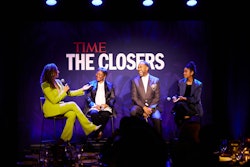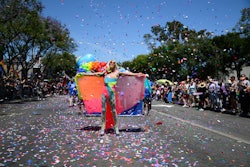
“An inclusive event experience is not just about ‘checking the boxes’ of gender-neutral restrooms and traditional ADA compliance, but a thoughtful and considerate approach applied to the program holistically,” explains Lynda DeMartino, owner and principal of Elite Hospitality Consultants LLC and the former diversity, equity, and inclusion lead for the Deloitte Global CEO team. “Speakers, especially emcees, are critical to welcoming and engaging your audience, and it is an opportunity for your event team to show your guests how important their comfort and dignity is to you throughout the planning process."
While a lot of focus is put on creating an inclusive lineup and an accessible venue, Meredith Flanagan—the workplace experience manager for architecture firm Gensler and a member of the Event Industry Council's Sustainability and Social Impact Committee—says that's only half the equation.
"Ensuring those values are evident throughout the event itself is what creates an environment in which participants can effectively live, learn, share, and innovate,” she says. “Briefing our speakers and production teams is one of the impactful ways that we can set our events up for success by aligning on language and practices that enhance each guest's experience."
BizBash chatted with DeMartino, Flanagan, and Carissa Roets—marketing copywriter for All American Entertainment, where she leads the speaker bureau’s DEI initiatives—about how speakers and event professionals can start using more inclusive language.
Recognize why it's so important to get it right.
“People will remember an unthinking word or unintentionally offensive phrase much more than they’ll remember anything else about an event,” advises Roets, who is a Certified Diversity Professional from the Institute for Diversity Certification, a specialized qualification designation that centers on the day-to-day aspects of workplace diversity, equity, and inclusion efforts.“As a keynote speaker or event planner, you want every member of your audience to engage with your message and your brand in a positive way,” Roets continues. “Incorporating inclusive language in your event’s marketing materials, keynote address, and daily conversational habits makes your message accessible to a wider audience and can go a long way in ensuring that everyone feels seen, heard, and valued.”
Select speakers who understand the importance of an inclusive event culture.
In addition to choosing speakers who represent a variety of backgrounds and lived experiences, DeMartino advises finding people who are aligned with the values and goals of your event, as well as your commitment to a fully inclusive culture. "I always ask on the first interview how they address the audience using inclusive language to ensure they address the needs of today’s diverse audiences. If they respond with a blank stare, I know immediately it’s not a good fit," she says. "This Columbia Business School publication has a good section on selecting and prepping speakers.”Use gender-neutral language.
“‘Ladies and gentlemen,’ ‘you guys,’ and ‘sir or madam’ are just a few examples of language that could exclude gender-fluid, gender-nonconforming, nonbinary, intersex, and trans individuals,” notes Roets. “Replace those phrases with gender-neutral terms. … If you don’t know someone’s pronouns or are talking about an unknown person, refer to the person by name or use the singular ‘they’ instead of ‘he or she.’”DeMartino likes to address crowds with terms like "‘colleagues,’ ‘everyone,’ ‘team,’ ‘exceptional group’—any term that does not limit to male/female only,” she says, adding that BuzzFeed's evolving Style Guide has been helpful to her when researching cultural, historical, and pop culture references.
Adopt person-first language.
Flanagan advises avoiding language that defines people or communities by their disabilities, diagnoses, or appearances. “Instead, I recommend using person-first language, such as 'a person who is deaf' or 'a person with a disability,'" she says. "I also recommend avoiding gendered language and referencing people's age as much as possible to establish a respectful, accepting environment."Don’t lean too heavily on idioms or colloquial expressions.
“As one who loves a good turn of phrase, I learned quickly during my tenure at Deloitte Global that idioms do not translate well, and they cause unnecessary confusion,” notes DeMartino. “While they may land well with a local crowd, a diverse audience is easily confused, and the miscommunication distracts from your mission."Roets also suggests avoiding "broad generalizations and colloquial expressions that could inadvertently be offensive, confusing, or exclusionary,” she says. “For example, a good keynote speaker knows their audience and how to tailor their message to create the most impact. They might avoid jargon that a general audience wouldn’t understand, but that same presentation might differ if they’re talking to a room full of other industry experts. That’s already inclusive language at work!”
Check if the event host already has their own DEI standards.
If you’re planning an event for a company other than your own, Flanagan suggests talking to the company's internal communications and human resources teams to see what guidance they may already have available. “At Gensler, we've developed extensive DEI materials to educate our employees on how to communicate more inclusively both inside and outside the office,” she explains.Be open to feedback.
“A lot of inclusive language doesn’t actually come naturally, even to people who advocate for diversity and inclusion. The goal is not to catch people saying the wrong thing; it’s about centering empathy and humanity in the way we communicate with each other,” says Roets, who recommends reading The Inclusive Language Handbook by Jackie Ferguson and Roxanne Bellamy.She continues, “Be willing to learn from diverse communities and individuals when they point out harmful language, get to know people and listen to how they refer to themselves instead of making assumptions, and be intentional about the language you use in your everyday conversations. When in doubt, ask someone what language makes them feel the most comfortable and respected.”
Take the time to educate yourself.
“Words matter, today more than ever, and we are in the business of hospitality first—may we never forget!” sums up DeMartino. “It is our job to make our guests feel welcome, included, and valued for exactly who they are. I have a brother with special needs and a gay daughter now in her 20s who struggles with mental illness and addiction, so I am acutely aware of the exclusionary behaviors and language and the negative impacts. Our lexicon is littered with phrases now considered to have negative connotations, many I was tossing around freely and unknowingly."While it can seem overwhelming to keep up with evolving standards over time, "it can become second nature the more you practice," DeMartino adds, advising event professionals to take some time to read through various resources. “I guarantee you will be shocked at how many often-used phrases are no longer appropriate. However, honoring those you encounter with thoughtful and intentionally inclusive language will help forge more genuine and authentic relationships. The time investment is worth it.”
Bonus: Here are some more of DeMartino's go-to resources on inclusive language:
MPI Minnesota Chapter DEI ToolkitDEI Events: Best Practices Resource Guide (asce.org)
CDC Inclusive Communication Principles
APA Inclusive Language Guidelines
Foundational Concepts and Affirming Language (harvard.edu)



















